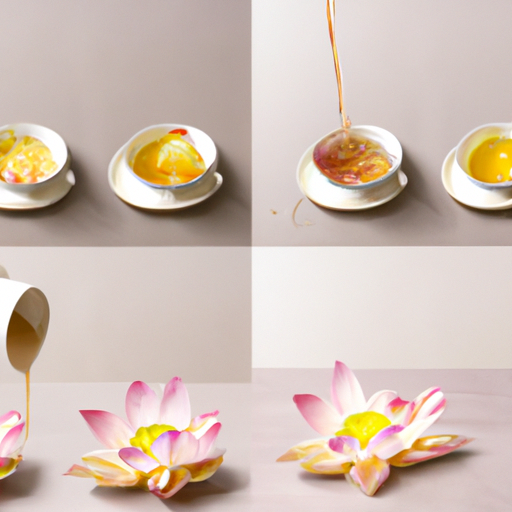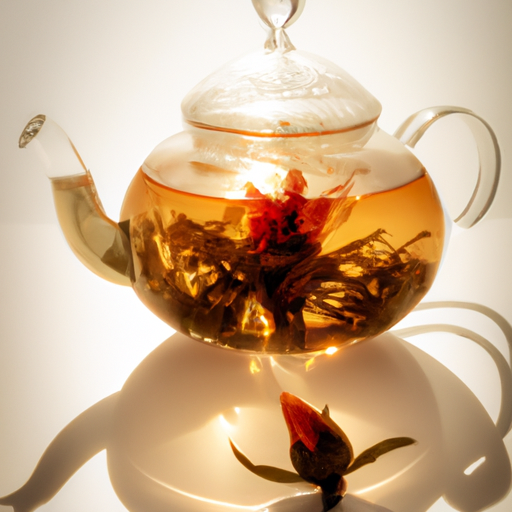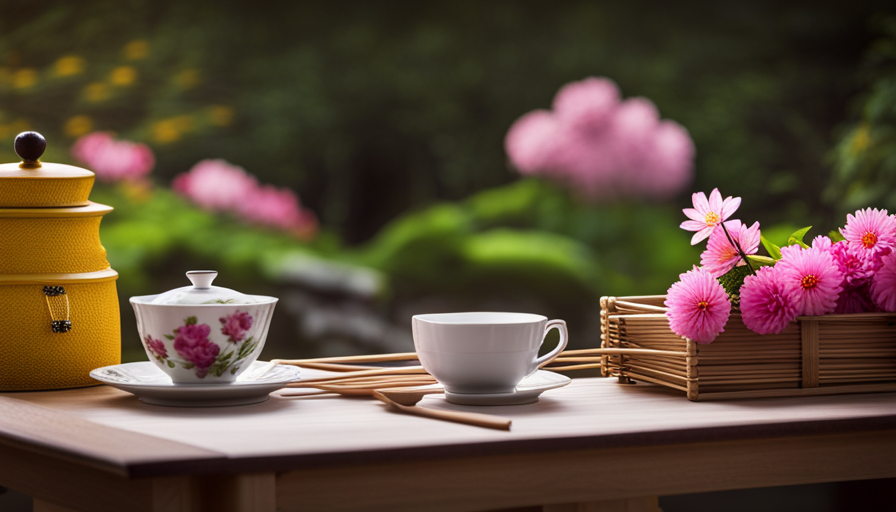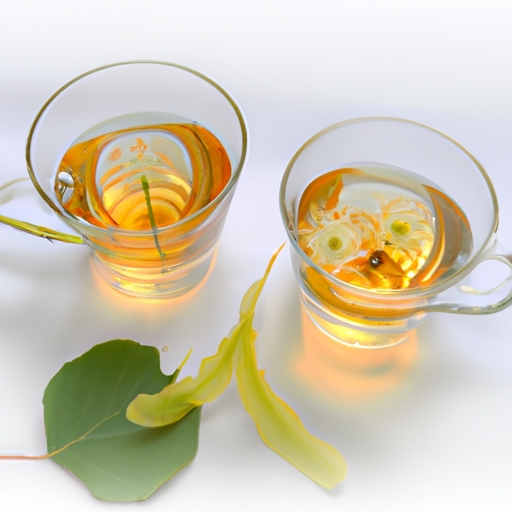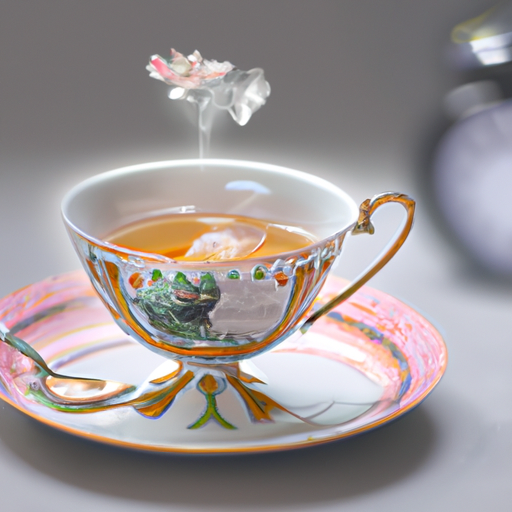Imagine a serene garden, filled with vibrant colors and delicate fragrances. In the heart of this oasis, a majestic lotus flower blooms, its petals unfurling in perfect harmony.
This symbol of purity and enlightenment has captured the imagination of cultures around the world for centuries. But did you know that the lotus flower can also be transformed into a delicate and aromatic tea?
In this article, I will guide you through the intricate process of making tea from fresh lotus flowers, a practice that dates back to ancient times. From selecting the finest lotus flowers to steeping them in hot water, I will share with you the secrets to creating a truly enchanting brew.
So, join me on this journey as we uncover the art of lotus tea-making and unlock the hidden wonders of this extraordinary flower.
Key Takeaways
- Select organic lotus flowers for quality and flavor.
- Harvest lotus flowers early in the morning when they are fully open and fragrant.
- Rinse lotus flowers under cool water to remove dirt and debris before preparing for tea.
- Infuse lotus flowers in hot water at the ideal temperature of 185°F (85°C).
Choosing the Right Lotus Flowers
Now, let’s dive into the fun part – choosing the perfect lotus flowers for your exquisite tea! When it comes to making tea from fresh lotus flowers, selecting the right ones is crucial.
To ensure the highest quality and flavor, it’s recommended to choose organic lotus flowers. Organic flowers are grown without the use of harmful chemicals or pesticides, resulting in a more natural and pure taste in your tea.
To find the best lotus flowers for tea, there are a few key factors to consider. First, look for flowers that are vibrant in color, with intact and blemish-free petals. These visual cues indicate freshness and will contribute to a more visually appealing tea.
Additionally, the fragrance of the lotus flowers should be pleasant and distinct. A sweet and floral scent is a sign of high-quality flowers.
When selecting lotus flowers, feel the petals to ensure they’re firm and plump. Avoid flowers that feel wilted or have soft spots, as these may not yield the desired flavors in your tea.
Once you’ve chosen the perfect lotus flowers, you can move on to the subsequent section about harvesting fresh lotus flowers, where we’ll explore the next steps in creating your delightful tea.
Harvesting Fresh Lotus Flowers
First, you’ll need to pluck those captivating blossoms, as if you were a master gardener with a secret obsession for delicate beauty. Harvesting fresh lotus flowers requires a careful approach to preserve their symbolic significance and ensure optimal health benefits in the resulting tea.
Here are three essential steps to successfully harvest fresh lotus flowers:
-
Choose the right time: Timing is crucial when it comes to harvesting lotus flowers. Early morning, just as the sun begins to rise, is the best time to pluck them. At this time, the flowers are fully open and emit a mesmerizing fragrance that adds to their allure.
-
Handle with care: Gently hold the stem of the lotus flower near the base and delicately twist it until it separates from the plant. Avoid pulling forcefully, as it may damage the flower or the plant itself. Treat each blossom as a precious gem, respecting its beauty and importance.
-
Maintain purity: As you harvest the flowers, ensure they remain untainted by dirt, dust, or any other impurities. Place them in a clean basket or container lined with a soft cloth to protect their delicate petals and prevent any damage.
By carefully following these steps, you’ll be able to gather fresh lotus flowers in their purest form, ready to be prepared for tea.
Preparing the Lotus Flowers for Tea
To fully experience the enchanting flavors and delicate aromas of lotus flower tea, the freshly harvested blossoms must undergo a meticulous preparation process.
The first step in preparing the lotus flowers for tea is to carefully choose the blossoms. Look for flowers that are fully open and vibrant in color, as these indicate freshness and optimal flavor. Avoid any flowers that are wilted or have blemishes.
Once you’ve selected the perfect lotus flowers, it’s important to gently rinse them under cool water to remove any dirt or debris. Be careful not to damage the delicate petals during this process. After rinsing, gently pat the flowers dry with a clean towel.
Lotus tea is not only a delicious beverage but also offers numerous health benefits. It’s known for its soothing and calming properties, as well as its ability to aid digestion and improve mental clarity. The tea is also rich in antioxidants, which can help boost the immune system and protect against various diseases.
Now that the lotus flowers are prepared, it’s time to move on to the next step: boiling water for lotus tea. With a pot of fresh water ready, we can now begin the process of making this exquisite and healthful beverage.
Boiling Water for Lotus Tea
Once the water’s boiling point is reached, the steam begins to dance and swirl, infusing the air with anticipation for the invigorating elixir that’ll soon be brewed.
The importance of water temperature can’t be overstated when making lotus tea. It’s essential to achieve the perfect balance between temperature and time to extract the delicate flavors and fragrances from the lotus petals. The ideal water temperature for lotus tea is around 185°F (85°C). This temperature allows the lotus petals to release their essence without being scorched or over-extracted.
There are different ways to flavor lotus tea, depending on personal preferences. Some people enjoy the natural, subtle taste of lotus petals, while others like to enhance the flavor with additions like honey, lemon, or ginger. Adding these ingredients during the brewing process can create a unique and delightful combination of flavors.
As the water boils and the steam envelops the room, it’s time to transition into the subsequent section about infusing the lotus flowers in hot water.
Infusing the Lotus Flowers in Hot Water
As the steamy water reaches its peak temperature, it eagerly embraces the delicate lotus flowers, coaxing out their enchanting essence. When making lotus tea, it’s crucial to choose the right temperature for infusing the flowers. Too hot, and the delicate flavors may be lost; too cold, and the full potential of the lotus may not be realized.
Ideally, the water should be heated to around 185°F (85°C), allowing the lotus flowers to release their unique flavors without scalding them.
Lotus tea isn’t only a delightful beverage but also offers a range of health benefits. The flowers are known for their soothing properties, which can aid in digestion and relieve stress. They’re also rich in antioxidants, which help to combat free radicals and promote overall wellness. Additionally, lotus tea can improve blood circulation and boost the immune system, making it an excellent choice for those looking to enhance their well-being.
Adjusting the steeping time for desired flavor is the next step in the lotus tea-making process. By allowing the flowers to steep for a shorter period, you can achieve a lighter and more delicate flavor. Conversely, a longer steeping time will result in a bolder and more robust taste. Finding the perfect balance between the two allows you to create a tea that suits your personal preference.
Adjusting the Steeping Time for Desired Flavor
Steeping the lotus flowers for a shorter duration produces a lighter and more delicate flavor, allowing the true essence of the enchanting flowers to gently dance on your taste buds.
When making tea from fresh lotus flowers, it’s important to experiment with different varieties to find the one that suits your taste preferences. Some lotus flowers have a sweeter and more floral flavor, while others have a slightly bitter undertone. By trying different varieties, you can discover the perfect balance of flavors that appeals to your palate.
In addition to experimenting with lotus flower varieties, adjusting the steeping temperature is crucial for achieving optimal flavor. The ideal temperature for steeping lotus flowers is around 175°F (80°C). This gentle heat ensures that the delicate flavors are extracted without any harshness or bitterness. Steeping at a higher temperature may result in a stronger and more robust flavor, but it can also lead to a loss of the subtle nuances that make lotus tea so special.
As the flavors develop during the steeping process, it’s important to keep a close eye on the lotus flowers. Depending on the variety and personal preference, the steeping time can range from 2 to 5 minutes. The longer the flowers steep, the stronger the flavor becomes. However, be cautious not to oversteep, as it may result in a bitter taste.
With the lotus flowers steeped to perfection, it’s time to move on to the next step: straining the lotus tea.
Straining the Lotus Tea
To strain your exquisite lotus creation, gently pour the brewed liquid through a fine mesh sieve, allowing the smooth and fragrant essence to trickle into your waiting cup. Straining is an essential step in the tea-making process as it removes any residue or impurities, ensuring a pure and enjoyable tea-drinking experience. There are various straining techniques you can employ to achieve the desired clarity and flavor profile. One effective method is to use a muslin cloth placed over the sieve to catch any fine particles, resulting in a pristine infusion. Alternatively, you can opt for a tea filter bag or a stainless steel strainer, both of which offer convenience and ease of use.
When straining your lotus tea, you not only enhance its visual appeal but also maximize its health benefits. Lotus tea is known for its antioxidant properties, which help boost the immune system and promote overall well-being. By straining out any sediment or impurities, you ensure that you are consuming a clean and potent brew, rich in vitamins and minerals. The refined taste and aroma of strained lotus tea make it a delightful beverage to savor and enjoy.
Moving on to the subsequent section about sweetening your lotus tea (optional), we can explore how to add a touch of sweetness to complement its delicate flavor.
Sweetening Your Lotus Tea (Optional)
Enhance the exquisite essence of your lotus creation by adding a touch of sweetness to your tea, like a gentle kiss of nectar on a summer breeze. Sweetening your lotus tea is an optional step that can elevate the flavors and bring a delightful balance to the herbal infusion.
There are several sweetening options you can choose from, depending on your personal preference and dietary needs. One popular choice is honey, which not only adds sweetness but also imparts its own unique flavor profile to the tea. Honey is known for its numerous health benefits, including antioxidant properties and soothing effects on the throat.
Another option is agave syrup, a natural sweetener derived from the agave plant. Agave syrup is low on the glycemic index and provides a subtle sweetness without overpowering the delicate lotus flavor.
Alternatively, if you prefer a calorie-free sweetener, stevia can be a great choice. Stevia is a plant-based sweetener that adds sweetness without any added calories. It is also known for its potential health benefits, such as helping to regulate blood sugar levels.
By sweetening your lotus tea, you can create a harmonious blend of flavors that will tantalize your taste buds and leave you feeling refreshed and energized.
Moving on to serving and enjoying your lotus tea, let’s explore the best way to savor this delightful creation.
Serving and Enjoying Your Lotus Tea
Once you’ve prepared your lotus tea, it’s time to indulge in the art of serving and savoring this exquisite beverage. The way you serve and enjoy your lotus tea can greatly enhance your overall experience. Here are three key considerations to keep in mind:
-
Serving Temperature: Lotus tea is best enjoyed hot or warm. The ideal serving temperature ranges between 160°F to 180°F (70°C to 80°C). This allows the flavors and aromas to fully develop, creating a delightful sensory experience.
-
Health Benefits: Lotus tea isn’t just a treat for your taste buds but also offers numerous health benefits. It’s known to promote relaxation, improve digestion, boost the immune system, and help with detoxification. By sipping on a cup of lotus tea, you can nourish both your body and mind.
-
Presentation: To fully appreciate the beauty of lotus tea, consider using clear glass teacups or delicate porcelain cups. The elegant petals and color variations of the lotus flower will be showcased, adding an aesthetic appeal to your tea-drinking experience.
Now that you know how to serve and enjoy your lotus tea, let’s delve into the next section and explore how to store and preserve lotus flowers for future use.
Storing and Preserving Lotus Flowers for Future Use
Now that you know how to serve and enjoy your delicious lotus tea, let’s talk about storing and preserving lotus flowers for future use.
Preserving lotus flowers is not only a practical way to ensure a steady supply of fresh flowers for tea-making, but it also opens up a world of possibilities for lotus flower crafts.
To preserve lotus flowers, start by selecting the freshest flowers you can find. Gently remove the petals and spread them out on a clean surface, making sure they’re not touching each other. Allow the petals to air dry for several days until they’re crisp and dry to the touch.
Once dried, store the petals in an airtight container, away from moisture and direct sunlight, to maintain their vibrant color and fragrance.
Preserved lotus flowers can be used in a variety of crafts, such as creating beautiful potpourri sachets, decorating candles, or adding an elegant touch to homemade soaps. Their delicate beauty and natural scent make them a popular choice for DIY projects and homemade gifts.
So, next time you find yourself surrounded by fresh lotus flowers, don’t forget to preserve them for future use and explore the world of lotus flower crafts. You’ll be amazed at the endless possibilities that await you.
Frequently Asked Questions
Can I use dried lotus flowers instead of fresh ones?
Yes, you can use dried lotus flowers as an alternative to fresh ones when making tea. To ensure the best results, it’s important to choose the right drying method. Air drying is the most common and effective technique, as it helps preserve the flavor and aroma of the lotus flowers.
Additionally, you can also consider using other ingredients such as dried herbs or spices to enhance the flavor profile of the tea.
How long does it take for lotus flowers to bloom?
The blooming time of lotus flowers can vary depending on several factors. Generally, it takes about 4 to 7 days for lotus flowers to fully bloom. However, this can be influenced by factors such as temperature, sunlight, and water quality.
Warmer temperatures and ample sunlight promote faster blooming, while cooler temperatures and poor water quality may delay the process. It’s important to provide optimal conditions for lotus flowers to ensure timely and beautiful blooms.
Are there any health benefits to drinking lotus tea?
Lotus tea offers numerous health benefits, making it a delightful beverage choice. Sipping on this floral concoction can have a positive impact on mental health, promoting relaxation and reducing stress.
Additionally, lotus tea holds cultural significance in various regions, symbolizing purity, enlightenment, and rebirth. Its delicate flavors and rich history make it a sophisticated choice for those seeking a soothing and culturally significant tea experience.
So, why not indulge in a cup and immerse yourself in the world of lotus tea?
Can I add milk or other flavorings to my lotus tea?
Adding milk to lotus tea can enhance its flavor and texture. The creamy richness of milk can complement the delicate floral notes of lotus tea, creating a well-balanced and comforting beverage.
However, it’s important to consider personal preferences and dietary restrictions. Some may find that milk masks the natural taste of lotus tea. Additionally, adding other flavorings like honey or spices can further enhance the complexity of the tea, but it’s crucial to strike a balance so as not to overpower the delicate lotus flavor.
Can I reuse the lotus flowers for another batch of tea?
Sure, you can definitely reuse lotus flowers for another batch of tea! Not only can you make multiple cups of tea with the same flowers, but there are also alternative uses for them.
It’s like a never-ending cycle of aromatic delight. Just imagine the versatility and beauty of lotus flowers blooming anew with every steep. Their essence can be infused in various recipes, potpourris, or even bath oils. The possibilities are as abundant as the petals themselves.
Conclusion
In conclusion, making tea from fresh lotus flowers is a wonderful way to experience the unique flavors and aromas they offer. By carefully choosing and harvesting the right flowers, preparing them correctly, and infusing them in hot water, you can create a soothing and rejuvenating beverage.
Did you know that lotus flowers have been used in traditional medicine for centuries? They’re believed to possess various health benefits, including reducing stress and promoting relaxation. So why not give it a try and indulge in the beauty and tranquility of lotus tea?

